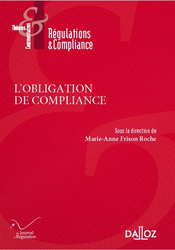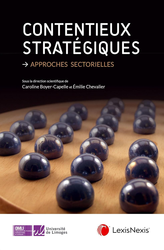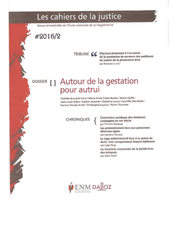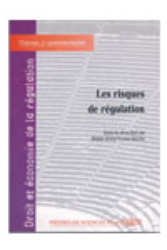Sept. 4, 2025
Thesaurus : Doctrine

► Full Reference: Fr. Ancel, "Devoir de vigilance et litiges commerciaux : une compétence à partager ?" (Duty of Vigilance and commercial disputes: a jurisdictional competence shared ?), in M.-A. Frison-Roche (dir.), L'Obligation de Compliance, Journal of Regulation & Compliance (JoRC) and Lefebvre-Dalloz, coll. "Régulations & Compliance", 2025, forthcoming.
____
📕read the general presentation of the book, L'Obligation de Compliance, in which this contribution is published
____
► English summary of this contribution (done by the Journal of Regulation & Compliance - JoRC) : The author considers the procedural issues raised by the duty of vigilance as the "cutting edge" of Compliance Law. After recalling the obligations imposed by the French 2017 law so-called "Vigilance Law" with regard to the Vigilance Plan, he emphasises the 2 types of action instituted by the law to ensure compliance with the duty of vigilance: the preventive action to put an end to the unlawful act, initiated after the formal notice has been served, and the civil liability action that can be brought under the conditions of general tort law, once the damage has occurred.
It is the French 2021 law so-called "Confidence Law" that has targeted the Paris Judicial Court of First Instance, in a jurisdiction that can be described as 'special' rather than exclusive. The author looks in detail at the disputes that this law both puts an end to and yet triggers in its turn, going back over the case law of the French Cour de cassation, which referred to the very nature of the Vigilance Plan and the subject matter of the dispute. It is therefore clear that the dispute may concern only the validity of the plan, in which case the Paris Court of first instance has jurisdiction, or it may concern a dispute, for example, between the company that drew up the plan and one of its partners, in which case jurisdiction is shared.
The article details all the procedural situations involving disputes in which the Vigilance Plan is more or less at the centre, which more or less implies either a lack of jurisdiction, or a stay of proceedings, or knowledge of the entire dispute by a court other than the Paris Court àf first instance, with the author proposing methods each time to develop case law so that the Duty of Vigilance does not emerge fragmented, at the same time as other jurisdictions, for example the commercial courts, will be dealing with the duty of vigilance insofar as it interferes with actions relating to commercial companies, the Plan having a direct link with the management of these companies, with the new definition of the corporate purpose of companies and with the exercise of the power of management of companies. According to the author, this "judicial syncretism", expressed in the case law of the Cour de cassation, is part of Compliance Law, which goes beyond the distinction between the traditional branches of law.
To give concrete form to this general view, the author states that when the subject of the action is the legality or validity of the plan, it therefore falls within the jurisdiction specially conferred by law on the Paris Court of First Instance. However, when the plan is only mentioned in an ancillary manner, and/or the duty of vigilance is mentioned in another capacity, the natural jurisdiction of the case law remains, for example if the nullity of a contractual stipulation is alleged. It is possible that this type of dispute is more frequent and more important than actions based primarily on the illegality of the Vigilance Plan. This contractual dispute could also arise from the fact that the company contractually imposes compliance with its own Vigilance Obligation on its employees and partners as part of the "adapted actions".
Judges, for example commercial judges, are then justified in interpreting and applying Vigilance obligations in the spirit of the law, particularly with regard to the aims pursued. It will be important for a common approach to emerge.
________
🦉this article is fully available for people enrolled in courses taught by Professor Marie-Anne Frison-Roche
________
Sept. 4, 2025
Thesaurus : Doctrine

► Référence complète : L. Aynès, "Comment l’arbitrage international peut être un renfort de l’Obligation de Compliance", in M.-A. Frison-Roche (dir.), L'Obligation de Compliance, Journal of Regulation & Compliance (JoRC) et Dalloz, coll. "Régulations & Compliance", 2024, à paraître
____
📕lire une présentation générale de l'ouvrage, L'Obligation de Compliance, dans lequel cet article est publié
____
► Résumé de l'article (fait par le Journal of Regulation & Compliance - JoRC) : L'auteur part du constat premier comme quoi l'arbitrage international et la compliance sont naturellement ajustés puisqu'ils sont tous deux une manifestation de la mondialisation, expriment un dépassement des frontières, l'arbitrage pouvant reprendre les buts monumentaux de la compliance puisqu'il a engendré un ordre arbitral substantiellement global.
Mais l'obstacle réside dans la source de l'arbitrage demeure le contrat, l'arbitre n'exerçant qu'une juridiction temporaire dont la mission est donnée par ce contrat. Pourtant l'avènement de l'ordre global arbitral permet ce dépassement, l'arbitre puisant dans des normes dont les buts monumentaux de la compliance et les engagements des entreprises peuvent faire partie. Ce faisant l'arbitre devient un organe indirect de ce droit de la compliance dont on voit l'émergence.
Puis la contribution évoque une seconde évolution, qui pourrait faire de l'arbitre un organe direct de concrétisation de la compliance. Pour cela, il faut que l'arbitre non seulement contraigne à l'exécution d'obligation de faire, ce qui est déjà le mouvement au titre des mesures provisoire, mais encore ait une conception plus ample ce qu'est le conflit pour lequel une solution est requise, voire se libère un peu de cette source contractuelle qui le cerne. Cela est possiblement en train de se dessiner, en miroir de la transformation profonde de l'office du juge.
________
🦉Cet article est accessible en texte intégral pour les personnes inscrites aux enseignements de la Professeure Marie-Anne Frison-Roche
Sept. 4, 2025
Thesaurus : Doctrine

► Full Reference: J.-B. Racine, "L’arbitre, juge, superviseur, accompagnateur ?" (The arbitrator, judge, supervisor, coach?), in M.-A. Frison-Roche (dir.), L'Obligation de Compliance, Journal of Regulation & Compliance (JoRC) and Dalloz, coll. "Régulations & Compliance", 2024, forthcoming.
____
📕read the general presentation of the book, L'Obligation de Compliance, in which this article is published
____
► English Summary of this article (done by the Journal of Regulation & Compliance - JoRC) : From the outset, the author sets out what is at stake in these terms: "Quel rôle peut ou pourrait jouer l’arbitre dans les dispositifs de compliance ? Selon le rôle qu’il est amené à jouer, il peut ou pourrait venir en renfort de l’obligation de compliance. Poser cette question, c’est poser la question des pouvoirs de l’arbitre et de son office. C’est aussi, d’une certaine manière, renvoyer à la notion même d’arbitrage." (What role can or could the arbitrator play in compliance systems? Depending on the role he/she is called upon to play, he/she can or could reinforce the compliance obligation. Asking this question raises the question of the powers of the arbitrator and his/her office. In a way, it also goes back to the very notion of arbitration).
In practice, arbitrators deal with compliance issues in their office as judges. This is illustrated by disputes involving allegations of corruption, where the arbitrators' ruling obviously cannot give effect to a corrupt practice unless they violate themselves international public order. But in this, the arbitrator is only applying a legal standard, the main issue being then the question of evidence, with compliance tools often serving as indicators of the corruption itself. Leaving behind the strict legal source and coming to the standards issued by the ICC about the fight against corruption, we really enter into the "compliance obligation", in the strict sense, when a contract appears.
International business practices standards are emerging, not only in the area of probity but also in the protection of human rights, for which arbitrators can now act as guarantors. Arbitrators can do this, in particular, through the emerging litigation relating to vigilance obligation, either directly when vigilance plans are at issue,, even if a legal rule gives a specific competence to a State court (as the French 2017 law does) or if we imagine that a plan itself includes a system for recourse to arbitration, which would imply a change in culture, or if we consider that soft law is in the process of emerging from the practices of international trade laying down a duty of vigilance that arbitrators could take up.
In the second part of his contribution, the author takes a second, bolder approach, namely that of an arbitrator who understands Compliance Law in that he/she would be more than a Judge, i.e. he/she would do more than settle a dispute by applying the law.
This would be conceivable given the tendency to consider that the arbitrator could modify contracts and if example is taken from the technique of arbitration practised for concentration disputes in merger law. To give arbitration the required regulatory dimension, this third party would have to be able to exercise a supervisory function, which the notion of "dispute" hardly lends itself to, especially as an arbitrator is only set up to be a judge, and if he/she ceases to be one it is difficult for him/her to remain an arbitrator.... However, it is conceivable that in Ex Post the arbitrator could perform the monitoring function often required in Compliance Law. The technique of disputes boards is inspiring in this respect. The two fields, Arbitration and Compliance, are thus destined to move closer together, as the two traditional limits, arbitrability and litigation, are in the process of evolving so that they no longer stand in the way of such rapprochements.
The author can therefore conclude: "C’est aux différents acteurs de la compliance de penser à l’arbitrage, et à la souplesse, la plasticité et la liberté qu’il offre, pour éventuellement le configurer spécialement au service des buts de la compliance." (It is up to the various players in Compliance to think about Arbitration, and the flexibility, plasticity and freedom it offers, in order to configure it specifically to serve the goals of Compliance Law).
________
Sept. 4, 2025
Thesaurus : Doctrine

► Référence complète : Th. Goujon-Bethan, "Les enjeux présents à venir de l’articulation des principes de procédure civile et commerciale avec la logique de compliance", in M.-A. Frison-Roche (dir.), L'Obligation de Compliance, Journal of Regulation & Compliance (JoRC) et Dalloz, coll. "Régulations & Compliance", 2025, à paraître
____
📕lire une présentation générale de l'ouvrage, L'Obligation de Compliance, dans lequel cet article est publié
____
► Résumé de l'article (fait par le Journal of Regulation & Compliance - JoRC) : L'auteur montre que le Code de procédure civile, parce qu'il est exceptionnellement bien conçu et dirigé, peut répondre à l'ampleur de la transformation que le Droit de la Compliance apporte.
Le Droit de la Compliance est normativement ancré dans ses Buts Monumentaux : ceux-ci sont portés en tant que tels devant le juge dans des "causes systémiques".
Or, le Code de procédure civile distingue, et les travaux des auteurs du Code comme ceux de la doctrine le montrent, qu'il faut distinguer le litige et le conflit. En effet, dans une "cause systémique" telle que le Droit de la Compliance les emporte nécessairement (climat, protection des internautes, égalité effective des êtres humains, durabilité des systèmes bancaires, etc.) ce sont des parties qui sont en litiges, tandis que le conflit embrasse lui les systèmes eux-mêmes et d'autres entités.
La procédure doit intégrer non seulement le litige mais encore le conflit. Cela implique notamment que l'on s'occupe non seulement du litige, mais encore du conflit, lequel ne s'éteint pas nécessairement avec le litige, et ne trouve pas les mêmes solutions que celles demandées par le litige. C'est notamment dans cette dernière perspective, essentiellement dans une procédure de "Cause Systémique de Compliance" que les techniques de médiation, d'amicus curiae, d'un juge qui se situe ex ante, etc., s'imposent. Elles sont disponibles à travers des articles du Code de procédure civile : il suffit que les juges, comprenant ce que sont les "Causes Systémiques de Compliance" s'en saisissent.
________
Sept. 25, 2024
Conferences

🌐follow Marie-Anne Frison-Roche on LinkedIn
🌐subscribe to the Newsletter MAFR Regulation, Compliance, Law
🌐subscribe to the Video Newsletter MAFR Surplomb
____
► Full Reference: M.-A. Frison-Roche, "Devoir de vigilance et litiges commerciaux : Anticiper l'"incidence" et s’organiser" ("Duty of vigilance and Commercial Litigation: Anticipating the "impact" and getting organised"), in L'incidence du devoir de vigilance sur les litiges commerciaux (The Impact of the Duty of Vigilance on Commercial Litigation), Tribunal de commerce de Paris (Paris Commercial Court), Droit & Commerce and Association Française en Faveur de l'Institution Consulaire (AFFIC), Tribunal de commerce de Paris, September 25, 2024, 17.15pm to 20pm
____
🌐read the report of this speech on LinkedIn (in French)
____
🧮see the full programme of this event (in French)
____
🧱consult the scientific coordination sheet of this event
____
🌐consult on LinkedIn a general presentation of this event (in French)
____
► English Summary of the conference: After listening to the enlightening speeches of François Ancel and Jean-Christophe Roda, I had the great opportunity to emphasise, as they did, that the duty of vigilance, in the respect of French laws of 2017 and 2021, with a view to the transposition of the CS3D, does not imply, so brutally as has been said, a lack of knowledge by judges other than those of the Tribunal judiciaire de Paris (Paris First Instance Civil Court) of this new Law, which is the extension of Compliance Law, as François Ancel reminded us.
Because Commercial Court judges deal with Contract Law on a daily basis, and because companies build their value chains through contracts that should be described as "regulatory contracts", the duty of vigilance has an "impact" on these disputes.
These disputes may be of a "systemic" nature.
This can only result not in jurisdictional trenches, but in "shared jurisdiction", along the lines drawn by François Ancel. This sharing must be built through a dialogue between judges, a necessary method on which Patrick Sayer concluded this elaborate conference on an essential and forward-looking subject.
________
May 20, 2023
Thesaurus : Doctrine
► Référence complète : Y. El Hage, "Le contentieux devant les juridictions étatiques", dossier "Les règlements européens DMA-DSA : un nouveau fair-play numérique européen", Dalloz IP/IT, 2023, pp. 283-288
____
► Résumé de l'article (fait par l'auteur) : "Le Digital Services Act (DSA) et le Digital Markets Act (DMA) devraient susciter un important contentieux à caractère privé et international.
Un contentieux privé, d'une part, parce que l'on imagine très bien des particuliers ou des entreprises souffrir d'un préjudice personnel causé par un opérateur non-respectueux de l'un des deux règlements. Prenons l'exemple de l'article 6, § 3, du DMA qui interdit aux contrôleurs d'accès (gatekeepers) d'imposer leurs logiciels par défaut, notamment leur navigateur internet. Aujourd'hui, Apple - entre autres - fait automatiquement de son propre logiciel, Safari, le navigateur par défaut sur tous ses appareils. Désormais, l'utilisateur final devra être invité par Apple à choisir le navigateur internet par défaut de son choix, notamment au moyen d'un écran multichoix. À défaut, les concurrents d'Apple pourraient parfaitement prétendre subir, personnellement, un dommage de nature concurrentielle. Le DSA et le DMA, toutefois, prévoient des sanctions sous la forme d'amendes, prononcées selon les cas par les autorités nationales ou européennes. Ces sanctions s'expliquent par l'objectif primordial de cette nouvelle législation européenne, qui est d'encadrer le comportement de certains opérateurs sur le marché numérique dans un but d'intérêt général. Une première interrogation peut être alors soulevée : en cas de manquement au DSA ou au DMA, une personne peut-elle exiger la réparation de son préjudice auprès des tribunaux judiciaires et non pas seulement espérer le prononcé d'une amende par les autorités nationales ou européennes ? En d'autres termes, le private enforcement de ces règlements est-il possible ?
Un contentieux international, d'autre part, parce que le marché numérique européen, objet des deux règlements, est par nature transfrontière. Cet aspect soulève alors immédiatement une autre interrogation : en cas de possibilité de private enforcement, devant quels tribunaux judiciaires l'action devrait-elle être menée ?".
____
🦉Cet article est accessible en texte intégral pour les personnes inscrites aux enseignements de la Professeure Marie-Anne Frison-Roche
________
April 17, 2023
Newsletter MAFR - Law, Compliance, Regulation

♾️ follow Marie-Anne Frison-Roche on LinkedIn
♾️ subscribe to the Newsletter MAFR Regulation, Compliance, Law
____
► Full Reference: M.-A. Frison-Roche, "Dans les causes systémiques : "délibérer" plutôt que "se disputer"" ("In systemic causes: 'deliberate' rather than 'argue'"), Newsletter MAFR - Law, Compliance, Regulation, 17 April 2023.
____
📧Read by freely subscribing other news of the Newsletter MAFR - Law, Compliance, Regulation
____
🔴To deal with "systemic causes", including systemic cases of compliance, move from "argument" to "deliberation" from the start
Compliance Law involves systems, for example banking, financial, digital, health, etc. When a dispute is brought before a judge, this dimension remains, whether before a judge of the Law or a judge of the merits, whether before a civil, criminal, commercial, administrative or European judge, etc. The judge's office must be adapted accordingly. And this is in the process of being done.
____
📧read the article ⤵️
Updated: Feb. 2, 2023 (Initial publication: June 23, 2021)
Thesaurus : Doctrine

► Full Reference: J. Jourdan-Marques, "L’arbitre, juge ex ante de la compliance ?" ("The arbitrator, ex ante judge of compliance?"), in M.-A. Frison-Roche (ed.), La juridictionnalisation de la Compliance, coll. "Régulations & Compliance", Journal of Regulation & Compliance (JoRC) and Dalloz, 2023, p. 317-334.
____
📕read a general presentation of the book, La juridictionnalisation de la Compliance, in which this article is published
____
► The summary below describes an article which follows an intervention in the scientific manifestation L'entreprise instituée Juge et Procureur d'elle-même par le Droit de la Compliance ("The company instituted Judge and Prosecutor of itself by Compliance Law"), co-organized by the Journal of Regulation & Compliance (JoRC) and the Faculty of Law Lyon 3. This colloquium was designed by Marie-Anne Frison-Roche and Jean-Christophe Roda, scientific co-directors, and took place in Lyon on June 23, 2021.
Due to the very close proximity of the content of this article to a scientific manifestation that was held previously, in the same series of colloquia, manifestation on Compliance and Arbitration, designed by Marie-Anne Frison-Roche and Jean-Baptiste Racine, and which took place in Paris on March 31, 2021 in Paris, it was decided with the author and the scientific managers of the scientific events concerned to publish the article not in Title I of the book, devoted to the topic of the Company instituted Judge and Prosecutor of itself by Compliance Law, but in Title III, devoted to the topic of Compliance and International Arbitration.
____
► Summary of the article (done by the Journal of Regulation & Compliance) : The article begins with a long introduction relating to the general relationship between Compliance and Arbitration.
Then the author in a first part examines the place of the Arbitration upstream of the occurrence of the dispute, aiming at the relations of the company in its organization with other companies for its economic activities, for example commercial agents. The author examines the way in which Arbitration can resolve difficulties which arise between them, including when these issues are otherwise apprehended by Compliance Law and the institutions in charge of it, in particular because of the facts of corruption are alleged and the fact is alleged by the debtor himself when payment has not yet been requested by the creditor. The legal question then becomes whether or not there is a "dispute".
Being even further upstream, the author takes the hypothesis of the adoption of a compliance program in which recourse to arbitration would be inserted by the Company, insertion which could then be at the origin of exemption from criminal liability, an arbitration award being able to produce such an effect if it is recognized in the legal order.
The second part of the article considers Arbitration in the absence of multiple parties, which could correspond to the acts issued by the Oversight Board of Facebook, this kind of tribunal and judge not being seized by parties to a litigation. It might be adequate to qualify this mechanism as an arbitration, even if this qualification is difficult to retain. In any case, if we did so by admission that a unilateral request gives rise to a jurisdictional mission, there should be guarantees surrounding such institutionalization. They can go through specific bodies for Compliance cases, outside or within existing arbitration institutions, which must then become the driving force in the matter. In addition, the choice of arbitrators should undoubtedly go through the institution itself so that impartiality remains unchallenged and profiles of arbitrators would be truly varied. The procedure would also have vocation to be inflected because of the absence of real litigation, justifying the adjustment of the adversarial principle (in the narrow sense of this one, linked to the debate) in particular by the intervention of amicus curiae and to avoid the fraud through arbitration and in procedure. In the absence of an adversary, the procedural office of the arbitrator could be reconsidered: without modifying the terms of the case, it would be appropriate for the arbitrator to have more power to decide on the adequate measures to be taken to remedy the non- conformity with compliance requirements. Finally, publicity seems to the author essential so that the arbitration is not instrumentalised by the parties, publicity which could also concern the debates and the documents produced. These admittedly very high requirements would in return give great credibility to the resulting award, justifying its scope, and one could consider labeling such a result, a label that the company could claim.
The author concludes that these transformations would move away so much from Arbitration that it would denature it, in particular because of the absence of litigation, but this allows Companies to outsource the management of the more and more heavier responsibility engendered by Compliance Law, by offering Compagnies the assistance of a judicial authority, as soon as the procedural guarantees are reinforced.
________
May 9, 2022
Publications

► Référence complète : Frison-Roche, M.-A., Notes prises pour la synthèse sur le vif de la conférence L'office du juge et les causes systémiques, in Cycle de conférences, Penser l'office du juge, Grand Chambre de la Cour de cassation, 9 mai 2022, 17h-19h.
____
► Résumé des notes prises au fur et à mesure de la conférence : les trois juges, Christophe Soulard, Président de la Chambre criminelle de la Cour de cassation, Fabien Raynaud, Conseiller d'Etat, et François Ancel, Président de la Chambre internationale de la Cour d'appel de Paris, invités à réfléchir et réagir à une hypothèse, à savoir l'existence parmi les cas qui leur sont apportés par les parties, sont intervenus à la fois d'une façon très diverse, très originale et exprimant pourtant l'unicité de l'art de juger.
Les notes prises ci-dessous montrent que les juges ont conscience que les temps ont changé et que, de plus en plus, les "systèmes" sont présents dans les causes qui, construites par les parties, leur sont présentées (1). Leurs analyses, réactions et propositions ont montré à ceux qui les écoutaient que pour appréhender des causes systémiques, les juges doivent être expérimentés (2). Ils ont eu souci de fixer des critères pour identifier la nature systémique des causes parmi la multitude de celles qu'ils traitent, justifiant alors un traitement procédural et décisionnaire particulier (3). L'auditoire a ainsi pu mesurer la part qui revient aux parties (4), puisque le système est dans la construction des faits de la cause et la part qui revient à l'office du juge (5).
Il apparaît alors que par un effet de miroir, l'office du juge se déplace de l'Ex Post vers l'Ex Ante (6), les trois juges décrivant et proposant des mécanismes concrets pour appréhender en Ex Ante cette dimension systémique et y répondre (7). Ils soulignent que cela s'opère en collaboration avec les avocats, dans une instruction élargie et le débat contradictoire (8), dans une collaboration qui s'opère en amont (9). Les trois magistrats ont recherché les techniques procédurales pour accroître la plus grande considération des systèmes (10) et les nouvelles organisations à mettre en place pour répondre à cette dimension systémique de certaines causes (11). Pour ce faire, une dialectique est à opérer vers, à la fois, de l'informel mais aussi plus de formel (12), l'ensemble produisant une meilleure réception méthodologique des systèmes par les juges (13) par une plus grande compréhension entre les juges, quel que soit leur niveau et les droits substantiels en cause, les autorités et les parties systémiques (14).
____
🎥Voir la vidéo de l'ensemble de la conférence
🎥 Voir la vidéo de la synthèse réalisée sur le vif par Marie-Anne Frison-Roche au terme de la conférence
____
📝Lire l'article de Marie-Anne Frison-Roche rendant compte au Dalloz de la conférence.
____
🚧 lire le document de travail L'hypothèse de la "cause systémique, réalisé préalablement à la conférence, pour préparer celle-ci.
_____
✏️ lire les notes exhaustives prises pendant la conférence⤵️
Oct. 14, 2021
Thesaurus : Doctrine

► Référence complète : C. Boyer-Capelle & E. Chevalier (dir.), Contentieux stratégiques. Approches sectorielles, LexisNexis, 2021, 220 p.
____
____
📗lire le sommaire de l'ouvrage
____
📗lire la table des matières de l'ouvrage
____
► Résumé de l'ouvrage (fait par l'éditeur) : "Née aux États-Unis, l'expression contentieux stratégique, ou strategie litigation, est employée dans la littérature juridique anglo-saxonne afin de désigner les hypothèses dans lesquelles la saisine du juge sur un cas particulier est en réalité le moyen d'attirer l'attention sur des questions sociales d'importance, en vue de provoquer une évolution des politiques ou législations existantes ou de permettre la bonne application de ces dernières. Cette utilisation stratégique des cours ou tribunaux cherche ainsi à transformer l'arène judiciaire en tribune au service d'une cause, le juge étant invité à acter les carences contestées ou à encourager les évolutions attendues dans le cadre d'un procès dont les tenants dépassent la dimension singulière du litige.Adapté au système juridique des pays de common law, le contentieux stratégique semble cependant progressivement s'acclimater dans des pays de tradition civiliste comme la France. Un nombre croissant de contentieux portent ainsi la marque de cette mobilisation d'un nouveau genre, développée au service de causes variées (environnement, protection des libertés individuelles, lutte contre la pauvreté, etc.) devant diverses juridictions.Les analyses sectorielles rassemblées dans cet ouvrage entendent proposer, à travers un cadre de réflexion commun, un état des lieux de cette évolution, permettant ainsi de donner corps à une notion aux contours encore souvent imprécis, d'éprouver le degré de maturation de cette nouvelle voie d'action et de s'interroger sur son impact réel et ses développements potentiels".
________
Dec. 8, 2020
Thesaurus : Doctrine

► Référence complète : S. Menétrey, "Le contentieux économique", in J.-B. Racine (dir.), Le droit économique au XXIe siècle. Notions et enjeux, LGDJ, coll. "Droit & Économie", 2020, pp. 173-209
____
📕consulter une présentation générale de l'ouvrage, Le droit économique au XXIe siècle. Notions et enjeux, dans lequel cet article est publié
____
► Résumé de l'article :
____
🦉Cet article est accessible en texte intégral pour les personnes inscrites aux enseignements de la Professeure Marie-Anne Frison-Roche
________
Updated: Sept. 6, 2016 (Initial publication: June 15, 2016)
Publications

Référence complète : Frison-Roche, M.-A., Face au fait des maternités de substitution, que peut faire le juge ?, in Dossier "Autour de la gestation pour autrui", Les cahiers de la justice, Revue trimestrielle de l'École nationale de la magistrature, ENM/Dalloz, 2016.
La GPA, ou maternité de substitution, est une pratique qui conduit à s'interroger sur la normativité juridique à travers la relation entre le droit et le fait, que celui-ci soit technologique, sociétal, économique ou géographique.
Face aux litiges qui lui sont soumis, le juge français doit rendre une décision en application des règles de droit en vigueur, y compris européennes.
La question ici posée est de savoir si, au regard de ses pouvoirs et de son office, le juge peut et doit dégager des solutions techniques plus fines et s'il peut et doit répondre par principe.
July 16, 2016
Law by Illustrations

Le petit Hubert traîne dans les musées. C'est si ennuyeux la culture ... Mais il y trouve l'occasion de regarder, et en face, des dames déshabillées, souvent plusieurs sur le même tableau, de quoi se réconcilier avec les musées : les trois grâces lorsqu'elles s'épaulent, les demoiselles d'Avignon lorsqu'elles dansent. Mais parfois elles s'affrontent. Elles ne s'habillent pas pour tant. A cette condition, le petit Hubert peut bien écouter l'histoire.
Ainsi, Athéna et Aphrodite et Héra se disputaient une pomme en or. L'on sait que les pommes dès la mythologie grecque sont sources de discorde, de paradis perdus et d'allergies diverses.
Zeus demanda à Pâris, berger - certes bien-né puisque fils de Priam et d'Hécube, mais enfin simple berger - de procéder à ce qu'il sera convenu d'appeler le "jugement de Pâris" et d'attribuer à l'une des trois la pomme disputée.
Le litige est en place et la procédure choisie : un objet (la pomme), un enjeu (attribuer la pomme à l'une d'elle), celui qui décide par un "jugement" (Pâris).
Certes, Pâris aurait pu couper la pomme en trois. Mais de la même façon que l'enfant vivant ne pouvait être coupé en deux par Salomon car l'on peut attribuer un cadavre lorsque l'enjeu du litige est d'attribuer un enfant vivant
Paris pourrait "décider" : non, Paris va "juger".
Que va-t-il faire ?
La façon dont il procède permet-t-elle de l'assimiler à un juge au sens juridique du terme ?
Lire ci-dessous.
Le "jugement de Salomon" étant une technique probatoire, la femme qui renonce à l'enfant plutôt que de le voir mourir se révélant ainsi sa mère.
Updated: July 31, 2013 (Initial publication: Sept. 20, 2011)
Teachings : Les Grandes Questions du Droit, semestre d'automne 2011

Updated: July 31, 2013 (Initial publication: Oct. 17, 2011)
Teachings : Les Grandes Questions du Droit, semestre d'automne 2011

Jan. 25, 2005
Publications

► Référence complète : Frison-Roche, M.-A., L’office de règlement des différends, entre régulation et juridiction, in Les risques de régulation, coll. « Droit et Economie de la Régulation », t.3, Dalloz / Presses de Sciences-Po, 2005, p. 269-287.
____
► Résumé de l'article : La notion d’office, si usuelle lorsque l’on parle du juge, doit aussi être utilisée concernant le régulateur, en ce qu’elle renvoie à la notion de mission, à la noblesse d’un service guidé par sa finalité. Mais autant il est usuel de considérer que le premier office d’un juge est de trancher les litiges, autant la doctrine estime qu’un régulateur ne prend en charge cette tâche que d’une façon auxiliaire. En effet, le juge serait toujours enfermé dans le rapport bilatéral entre les parties qui se disputent, alors que le régulateur est en charge d’un système.
____
____
📕 Lire une présentation générale de l'ouvrage dans lequel l'article est publié.
____
Lire le résumé développé de l'article ci-dessous
Oct. 12, 1981
Thesaurus : Doctrine
► Référence complète : : J. Carbonnier, De minimis..., in Mélanges dédiés à Jean Vincent, Dalloz, 1981, p. 29-37 ; repris in Flexibles droit, 10ième éd., L.G.D.J., p. 74-83.
____
► Présentation de l'article : Le Doyen Carbonnier s'appuie ici sur la formule romaine : De minimis non curat praetor : le juge ne s'occupe pas des litiges mineurs.
Il était de bonne administration de la justice que d'empêcher ce type de litige d'arriver jusqu'au juge.
Puis la formule fût présentée comme familière ou proverbiale, avant qu'au XXième on l'habille d'une façon plus juridique à travers les exigences d'intérêt et de qualité à agir.
Mais le Doyen Carbonnier reprend la jurisprudence sur le droit au nom, qui semble traiter celui-ci comme peu de chose, et celle sur l'empiètement sur le terrain d'autrui, qui montre le grand cas fait à la propriété, la confrontation des deux montrant que cela est appréciation de valeurs.
Dans la deuxième partie de l'article, l'auteur met en doute la persistance même de l'adage en filigrane dans le droit.
En effet l'article 31 du Code de procédure civile se contente d'un intérêt "légitime" pour permettre à une personne de saisir le juge, sans se soucier de l'ampleur de cet intérêt. Il faudrait que l'intérêt dérisoire soit une preuve de la malice de la démarche pour qu'il justifie un rejet ou une sanction pour abus.
En outre, "chacun est juge de son intérêt" et l'ardeur consacrée à l'action devrait suffire à présumer l'existence de cet intérêt.
Dans la troisième partie de l'article, l'auteur montre que désormais les petits peuvent se faire entendre, malgré l'ombre portée de l'adage. Comme le souligne le Doyen : "les demandes des pauvres sont le plus souvent de pauvres demandes".
On est aujourd'hui passé d'une "justice de charité" à une reconnaissance de plein droit des revendications de justiciables "qui se font fort ... de leurs faiblesse". Le franc symbole en dommage et intérêt en est l'exemple.
_____